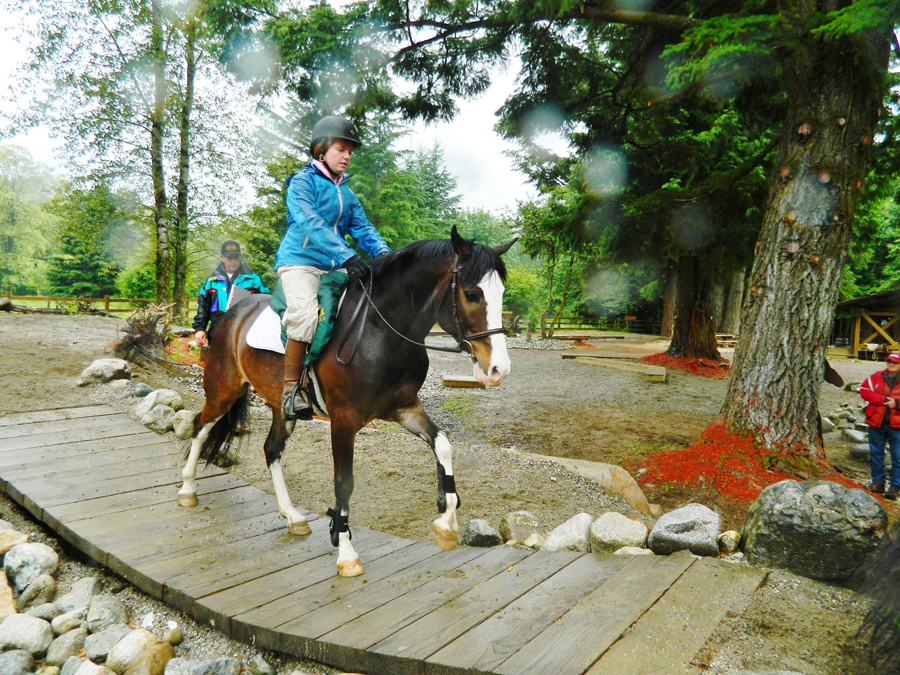Build a Confident Horse with this Challenging Obstacle
by Mark Bolender

Being proficient at negotiating a suspension bridge – or merely a bridge that’s swinging – with your horse is one of the biggest challenges of the mountain trail rider. Yet, mastering this obstacle is relatively easy if the problem is broken down into simple, small steps.
The first step is to make sure that you have your Bolender Bubble in place. This means that your horse understands that it can’t invade your personal space under any circumstance. If this fundamental principle is not firmly established, then back up and perfect it before you introduce the suspension bridge to the horse.
Also, it’s important to use a suspension bridge for training that’s low to the ground – where the lowest “sag” is no more than 12” above the ground. The bridge should also be 42-48 inches wide and about 20 feet long. Once your horse is accustomed to the moving low bridge, learning the high suspension bridges will come easier.
The next step is to start on the ground by approaching the bridge perpendicularly and introducing your horse to the center sag. Often the horse will inspect it and shy away as soon as it moves. You will need to do what it takes to have your horse inspect the bridge further and mentally work it out.
Next stand on the bridge and ask the horse to put one, then two feet onto the bridge. Depending on the horse, this will take a few minutes. Your job is to stand quietly and wait for the horse to respond. I allow a horse all the time that it needs to look at and get used to the movement of the bridge. Each horse will respond very different; allow it time to think.
Put as much pressure as needed on your horse so it considers stepping up on the bridge. When you see it stepping up close to the bridge, stop the pressure immediately and allow it to process. Your main job is to keep your horse from thinking of ways to avoid stepping up. Finding “a way out” to avoid the scary object is a natural instinct, and you must cut that off before it begins. Simultaneously allow your horse all the time it needs to consider and to process this scary, moving thing.
After your horse is comfortable with the bridge’s movement, ask it to walk onto the bridge at the sag. Ask your horse to stand with all four feet on the bridge. Then ask your horse to walk over the bridge several times, back and forth. Finally, starting at the sag, ask your horse to get onto the bridge and turn (left or right) and walk all the way to the end to the footing of the bridge. Make sure that you work only half of the bridge (from the center sag) each way before asking your horse to complete the entire bridge. Let the horse continue to enter and walk in each direction from the sag until it feels comfortable.
Once it’s comfortable walking across the bridge it’s time to ask your horse to consider walking over the whole bridge – from entrance to exit – while you’re riding. Don’t worry if your horse is slightly uncomfortable with the bridge once you’re in the saddle. Much of your ground work training will remain in its mind, but not all of it. Part of the reason for this is that your horse can’t see your body language. Be patient. You must encourage but not force it – which is often a subtle difference.
Make sure you let your horse inspect the bridge with its nose. This means that you must allow it to lower its head. Often a horse will try to turn away so simply keep it focused on the bridge. This will take some skills with the reins because you need to keep a loose rein while keeping your horse aligned parallel with the bridge. Once your horse steps onto the bridge allow it time to think. Keep a very soft contact with its mouth to prevent rushing across the bridge. Cross the bridge several times and then ask your horse to stop while standing in the middle of the bridge.
Use this method and with patience and a short amount of time your horse will be walking over the bridge with boldness and a quiet confidence.
Happy Trails and Bolender Blessings!
Published in December 2012 Issue

Mark Bolender is the nation’s leading expert in Mountain Trail, Extreme Mountain Trail, and Competitive Trail. He’s a three-time National Champion and one of the most popular trainers in the country. Today, Mark’s unique style of horsemanship has made the Bolender brand synonymous with these disciplines.
Mark has written for numerous national magazines and authored the popular book, Bolender’s Guide to Mastering Mountain and Extreme Trail Riding. Mark and his horse Checkers hold the sport’s all-time highest honors. Checkers was distinguished by becoming the 2020 Breyer Horse.
Mark and Lee Bolender founded the International Mountain Trail Challenge Association (IMTCA) to promote these sports. Today, the IMTCA trains judges, coordinates activities, and maintains certifications around the world.
Mark owns and operates Bolender Horse Park in Washington State. Mark has also designed and built Mountain Trail courses around the world.

